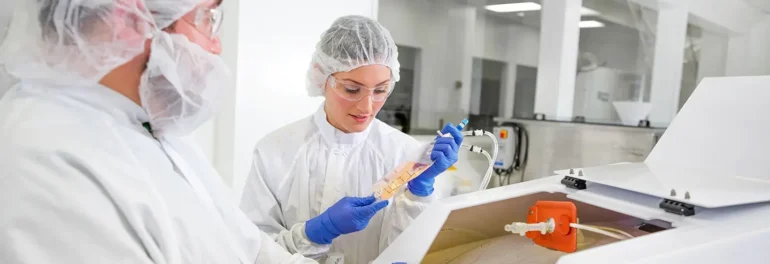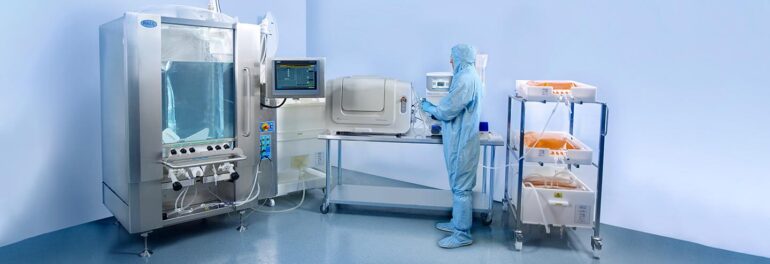Single-use technologies (SUTs) have introduced a broad range of cost and operating efficiencies to bioprocessing operations. Both in upstream and downstream, the technology offers new flexibility — but managing operations effectively can be challenging without a deeper understanding of the single-use life cycle and the effective role SUTs can play throughout biomanufacturing operations.
For most of the biopharmaceutical industry, the processing of large molecule therapeutics of all kinds has traditionally been tied to proprietary large-scale stainless steel systems featuring miles of stainless steel piping, fixed holding tanks, mixers, bioreactors and cleaning equipment. Although fixed systems offer their own operational economies, especially at commercial scale, biopharmaceutical manufacturers are seeking flexible process solutions to help them better respond to the changing business, product, financial and regulatory circumstances facing the industry today.
However, with the advent of single-use technologies (SUTs), biopharmaceutical manufacturers now have a viable, affordable path to introduce flexibility and new operational economies into bioprocessing operations.
Single-use technology is not applicable to all molecules or bioprocess steps and, in and of itself, will not assure a better product, improve margins or make a more competitive product. However, SUTs can deliver a range of benefits if assessed thoroughly before implementation. For better outcomes, a lifecycle approach to the assessment can help an organization transition successfully to SUTs and realize the benefits of the technology. Best practice puts the assessment process in front of a cross-functional operations team to review and understand the complete manufacturing process as it relates to adopting and integrating SUTs.
A Singular Mindset for SUT Assessment
Instead of looking at individual components and assemblies, real value comes from looking at a given process with a broader perspective, examining operations comprehensively for interactions and adjacencies, not only with components and systems, but throughout operations and with cross-functional stakeholders. Following are key elements that can help frame an effective assessment program and define a sustainable single-use lifecycle for a given process and plant setting.
For better outcomes, a lifecycle approach to the assessment can help an organization transition successfully to SUTs and Realize the benefits of the technology.
Validation Planning (Qualification, Commissioning and Validation)
To validate a given manufacturing process and be compliant, a biopharmaceutical manufacturer must submit to regulators an overall master plan. This plan covers plant, equipment, process, personnel and documentation, including design (DQ), installation (IQ), operation (OQ) and process qualification (PQ) elements that support the plan. Design qualification associated with conventional, stainless steel systems has typically taken place prior to the construction of the equipment. Single-use technologies, however, offer the ability to decouple some DQ activities, like material compatibility, because SUT materials may be prequalified. Single-use equipment is often less complex than conventional stainless steel counterparts. This simplicity offers an opportunity to reduce the effort and time associated with IQ and OQ.
Training for Excellence in SUT Operations
Compared with conventional fixed-pipe stainless steel systems, SUTs will require fresh training and an alignment of operations to suit the more intensive reliance on operators for set-up, installation and use. Bear in mind operators are not the only functional group to be addressed. Single-use technologies introduce a whole new supply and inventory management aspect to operations, and warehouse/material handling personnel will be impacted.
Effective training is critical to sustaining the operational efficiencies associated with SUTs. New routines and training should be introduced to address both the mechanical and material intricacies of SUT systems and the operational procedures to keep operations functioning at optimal levels.
Assessing Operations
The transition from process development to manufacturing scale involves managing intensive change, typically in operating spaces (classification), layout (interconnected, adjacent unit operations) and personnel (type and training level). The efficient flow of material, personnel and waste through the manufacturing environment is critical to effective operations and its ability to preserve the integrity of the manufacturing space. Single-use components and assemblies are involved in most, if not all, process steps and the volume of SUT materials introduced into the manufacturing space is significant. As such, staging, use and disposal of these items are central to properly aligning manufacturing’s material and waste workflows.
Institutionalized standard operating procedures (SOPs) are necessary to formalize the activities and ensure a robust manufacturing process. Within the manufacturing space, SOPs should include contingencies for single-use component/assembly replacement, or substitution, and reinforced with training. Materials inventory, transfer and record-keeping should not be overlooked either.
Design and Documentation
In the biomanufacturing suite, the process train forms an integrated manufacturing line with all the necessary unit operation and support equipment. Unlike manufacturing, process development is focused more on technical performance, rather than equipment integration and overall, integrated manufacturing process operations.
Process development activities can offer an appropriate proving ground for specifying single-use assemblies to suit specific unit operations. Integration, or more specifically, the interconnection of various adjacent unit operations that make up the manufacturing process using single-use assemblies, requires a thorough understanding of the available space and layout as well as specifics associated with connections and logistics, product transfers, etc. At this point documentation requirements can also be determined for the drugs manufacturing program.
Single-use technologies introduce a whole new supply and inventory management aspect to operations, and warehouse/material handling personnel will be impacted.
Sourcing and Procurement
Unless a drug maker intends to design and manufacture single-use elements in house, supply chain partners are required. Finding qualifiable SUT suppliers is paramount and critical to secure a reliable supply. Representing the internal stakeholders, the sourcing function must be able to communicate the appropriate business and technical requirements, externally, to potential suppliers. Single-use system design, unit quantities, delivery timelines and documentation requirements are a few of the common considerations. Single-use technology has also increased the interconnectivity of the supply chain. Supply chain transparency is important because buyers often source components, and semi-finished and finished assemblies, from the same lower-tier suppliers used by other top-tier suppliers within the supply chain. With a focus on the drug manufacturing process, it should be clear as to the state of an assembly’s design: prototype versus final released version.
If any design and review steps remain, procurement plans must reflect this uncertainty. Using a supply agreement to summarize/catalog and codify the quality, commercial, technical and documentation aspects of the single-use lifecycle will go a long way toward keeping individual yet interdependent businesses aligned.
Continuous Improvement Ahead
Real-time data, operator feedback and input from the supply chain contribute to a more functional, efficient single-use lifecycle. In every aspect it is important to consider the internal and external stakeholders involved in the SUT continuum, and work to promote communication among all parties to support sound, GMP-compliant operations and continuous improvement over the long term.
Conclusion
Single-use technologies, inclusive of components and assemblies, have become an effective means for many biopharmaceutical manufacturers to achieve improved product quality, greater plant utilization, and overall operational effectiveness. When implementing SUTs, the biopharmaceutical industry has come to understand that the greatest benefits come to those who have analyzed their end-to-end biomanufacturing operations comprehensively and have defined a single-use lifecycle best suited to their products, process and organization.
Originally published on PharmasAlmanac.com on October 26, 2017.







